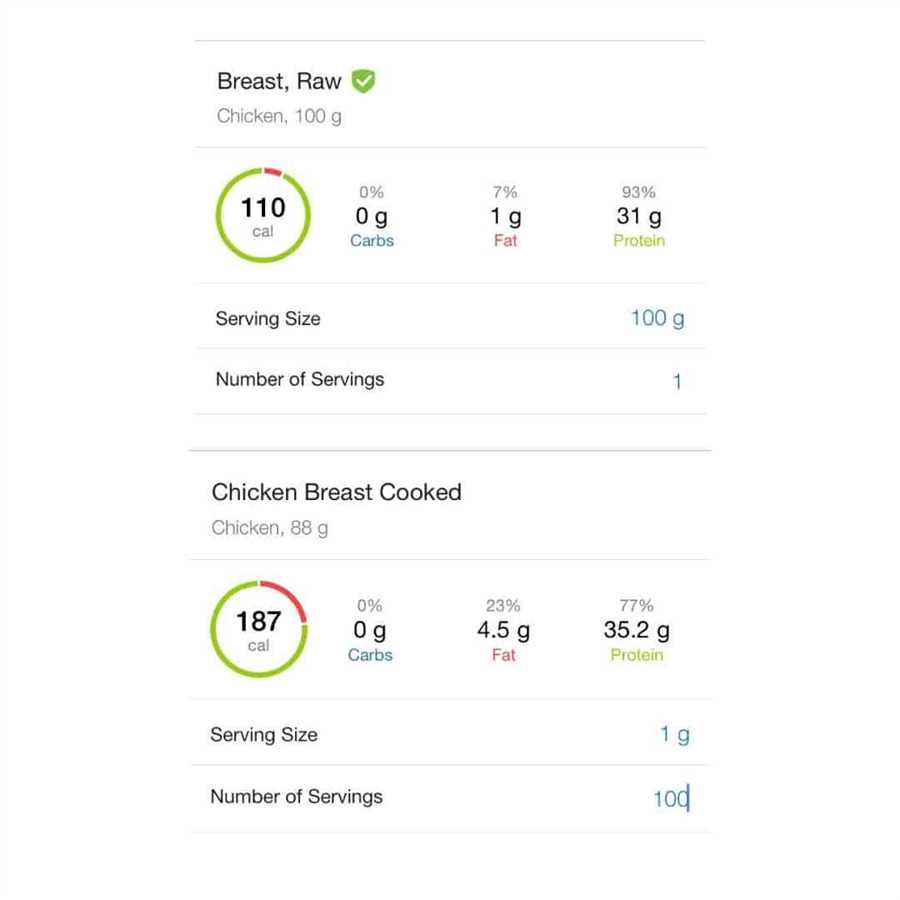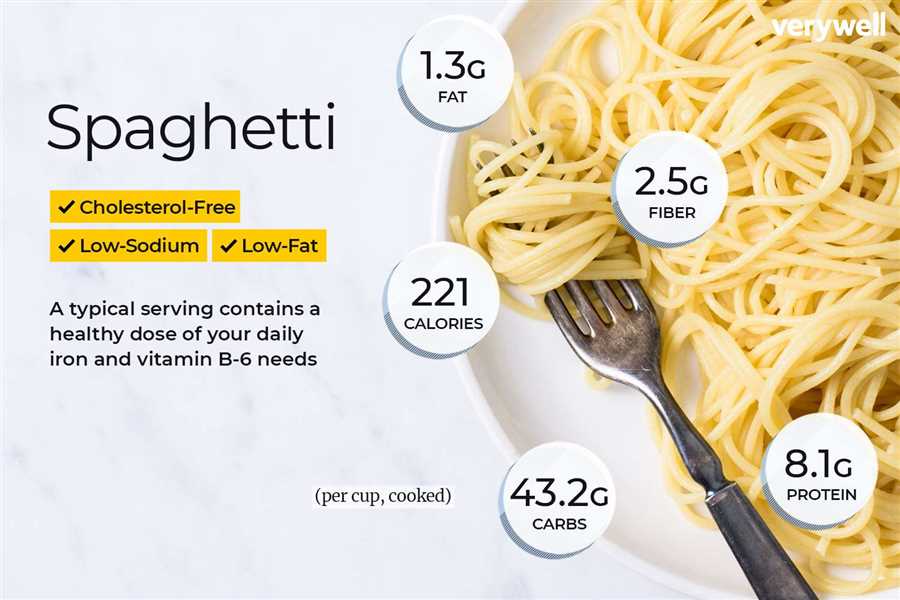

When it comes to tracking your macronutrients (macros), such as carbohydrates, protein, and fat, it’s essential to measure your food accurately. One common question that arises is whether you should weigh pasta dry or cooked.
The weight of pasta can change significantly after it’s cooked. This is because dry pasta absorbs water during the cooking process, which makes it heavier. If you measure your pasta after it’s been cooked, you will end up with a larger portion and potentially inaccurate macronutrient calculations.
To get the most accurate macros, it’s recommended to weigh your pasta before cooking it. This ensures that you’re tracking the correct amount of carbohydrates, protein, and fat in your diet. However, if you’ve already cooked your pasta and forgot to weigh it before, don’t fret! You can still estimate the dry weight by referring to the package’s nutrition information and using an appropriate conversion factor.
Trending NowEtekcity Smart Food Scale with AppTrack 19 nutrients effortlessly with an appThis smart kitchen scale allows you to monitor your nutrient intake and create detailed nutrition reports using the Vesync app. Its sleek design and precision sensors help you maintain your health goals with ease.Pro Tip: If you’re following a specific recipe or tracking your macros for weight loss or muscle gain, weighing your pasta dry is the best approach. It allows you to have better control over your portion sizes and achieve more accurate macronutrient calculations.
Remember, accurately tracking your macros is essential for achieving your health and fitness goals. Whether you prefer your pasta dry or cooked, make sure you weigh it appropriately to ensure precise calculations and keep yourself on track.
Understanding Pasta Weight for Macros
When it comes to tracking macronutrients, knowing the accurate weight of your pasta is crucial. Many people wonder whether they should weigh their pasta when it’s dry or cooked. Let’s dive into the details to better understand how to measure pasta for tracking your macros.
Measuring Dry Pasta:
When you weigh pasta in its dry form, you are calculating its nutritional value before it absorbs any water during the cooking process. This method is commonly used by people who prefer to measure their food in its uncooked state. It’s important to note that the cooking process will cause the pasta to absorb water and increase in weight. Generally, dry pasta will roughly double in weight after being cooked.
Calculating your macros based on dry pasta is straightforward. Simply weigh the amount of dry pasta you plan to cook and refer to the nutrition information on the packaging. This will give you a more accurate representation of the macronutrients you are consuming.
Measuring Cooked Pasta:
Some people prefer to weigh their pasta after it has been cooked. This method can be more convenient for those who cook pasta in large batches and store it for later use. When you measure pasta in its cooked form, you are accounting for the water it has absorbed during cooking. This can result in a higher weight compared to measuring dry pasta.
If you choose to weigh your pasta after cooking, it’s important to adjust your macronutrient calculations accordingly. You can find nutrition information for cooked pasta by referring to reliable sources or using nutrition tracking apps. Be sure to select the appropriate entry that matches your cooking method and portion size.
Conclusion:
Whether you weigh your pasta dry or cooked for tracking macros depends on your personal preference and cooking habits. Measuring dry pasta provides a more accurate representation of its nutritional content, while measuring cooked pasta accounts for the water it has absorbed. Whichever method you choose, be mindful of portion sizes and adjust your macronutrient calculations accordingly for a more accurate tracking experience.
Difference between Dry and Cooked Pasta

When it comes to tracking macros, it’s important to note the difference between weighing dry pasta and cooked pasta. The weight of pasta can vary significantly depending on whether it is measured before or after cooking.
Dry pasta is usually measured by weight before it is cooked. This is because the weight of pasta can change significantly when it absorbs water during the cooking process. So, if you’re tracking your macros and want to be accurate, it’s best to weigh your pasta before cooking.
Cooked pasta, on the other hand, will generally weigh more than its dry counterpart. This is because the cooking process adds water to the pasta, which increases its weight. So, if you’re measuring your macros after the pasta has been cooked, make sure to account for the extra weight that the water adds.
Keep in mind that the exact difference in weight between dry and cooked pasta will vary depending on the type of pasta and how it is cooked. Generally, pasta will absorb about 2 to 2.5 times its dry weight in water, but this can vary. It’s always a good idea to check the nutritional information on the pasta packaging or use a reliable online source to get an accurate estimate of the macronutrients in your cooked pasta.
In conclusion, if you’re tracking macros and want to be precise, it’s best to weigh your pasta dry before cooking. However, if you’re unable to do so or if you’re using a pre-portioned amount of pasta, make sure to account for the difference in weight between dry and cooked pasta to get an accurate measurement of your macros.
Weighing Dry Pasta for Macros
When it comes to tracking your macros, especially for weight loss or muscle gain goals, weighing your food accurately is crucial. Pasta is a versatile and popular food choice, but how should you weigh it?
Dry Weight vs Cooked Weight
When measuring pasta for macronutrient tracking, it’s best to weigh it dry. The reason for this is that the weight and nutrient content of pasta can change significantly when cooked. By using the dry weight, you can ensure more accurate calculations and better control over your macros.
Weighing Process
To weigh your pasta properly, start by checking the nutrition label on the packaging for the serving size and nutritional information per serving. Typically, the label will provide information for both dry and cooked pasta. Make sure to note down the values for dry pasta as this is what you’ll be weighing.
Next, use a kitchen scale to measure out the desired amount of dry pasta. Place the scale on a flat surface and container on top. Zero out the scale, then add the pasta until you reach the desired weight.
Remember to account for the number of servings you plan to cook. If the nutrition label provides information per 100g, and you want to cook 200g of pasta, you will need to double the values on the label when tracking your macros.
By weighing dry pasta for your macros, you can better manage your portion sizes and accurately track your macronutrient intake. This level of precision can be especially important if you have specific dietary goals or are following a specific nutrition plan.
Remember: Be consistent in using the same method for weighing your pasta throughout your tracking journey to ensure accurate macros.
Always consult with a registered dietitian or healthcare professional before making any significant changes to your diet.
How to Measure Cooked Pasta for Macros
When tracking your macros, it’s important to accurately measure the amount of pasta you are consuming. While it may seem logical to measure the pasta dry before cooking, it’s actually recommended to measure it after it has been cooked.
Here are step-by-step instructions on how to measure the cooked pasta for macros:
- Start by cooking your desired amount of pasta according to the package instructions. Be sure to use a kitchen scale to measure the amount of dry pasta you are cooking.
- Once the pasta is cooked to your desired texture, drain it well and let it cool slightly.
- Using a clean kitchen scale, weigh the cooked pasta in grams or ounces. Make sure to deduct the weight of any cooking water or sauces.
- Record the weight of the cooked pasta for your macro calculations.
Measuring the pasta after it has been cooked ensures a more accurate measurement, as the cooking process can cause the pasta to absorb water and increase in weight. This is especially important if you are following a strict macro counting regimen.
Remember, accurately tracking your pasta intake can help you stay on track with your macro goals and maintain a balanced diet.
Importance of Accurate Pasta Measurements

Accurate pasta measurements are crucial for tracking the macronutrients present in your pasta dish. Whether you weigh your pasta dry or cooked can have a significant impact on the nutritional information you record.
When you weigh pasta dry, you get a more accurate representation of the actual amount of pasta you are consuming. This is because pasta absorbs water and expands as it cooks. By measuring it dry, you can ensure that you are accurately tracking your portion size for calculating macros.
On the other hand, if you weigh pasta cooked, you might end up with a higher weight due to the absorbed water. This can lead to miscalculations and inaccurate tracking of the macronutrients. If you are trying to meet specific dietary goals or follow a particular diet plan, this variation in measurement can have a significant impact.
To get the most precise nutritional information, it is recommended to weigh pasta dry before cooking it. This way, you can accurately portion your pasta and track the macros according to the dry weight. However, if you prefer to weigh it cooked, make sure you adjust the nutritional values accordingly.
Accurate pasta measurements can help you make informed decisions about your diet and ensure that you are meeting your specific nutritional goals. Whether you’re counting calories, tracking macros, or following a specific diet plan, knowing the accurate portion size of your pasta is essential.
Questions and answers
Do you weigh pasta before or after cooking?
You should weigh pasta before cooking if you want to track the accurate macros. The nutritional information on the pasta package is usually provided for the dry pasta.
Should I weigh pasta dry or cooked for tracking macros?
If you want to track the macros properly, it’s recommended to weigh pasta before cooking. The nutritional values provided on the packaging are usually for the dry pasta, so that’s what you should use for accurate tracking.
How do I measure pasta accurately for counting macros?
To count macros accurately, you should measure pasta before cooking. Weigh the dry pasta using a food scale for the most accurate measurement. The nutritional values on the packaging are typically for the dry pasta, so make sure to follow those.
Can I weigh pasta cooked instead of dry for macros?
While it’s technically possible to weigh pasta after cooking for tracking macros, it’s not recommended. The nutritional values on the packaging are usually provided for the dry pasta. If you want to accurately count macros, weigh the pasta before cooking.
Does weighing pasta dry or cooked affect the accuracy of macros?
Weighing pasta dry or cooked can affect the accuracy of macros. To track macros accurately, it’s best to weigh the pasta before cooking. The nutritional information on the packaging is typically provided for the dry pasta, so measuring it before cooking ensures accurate tracking.







